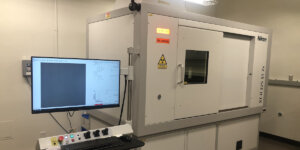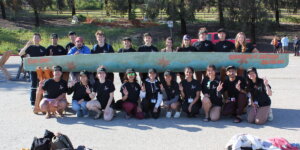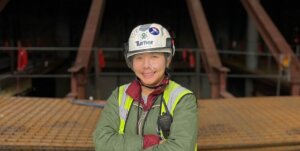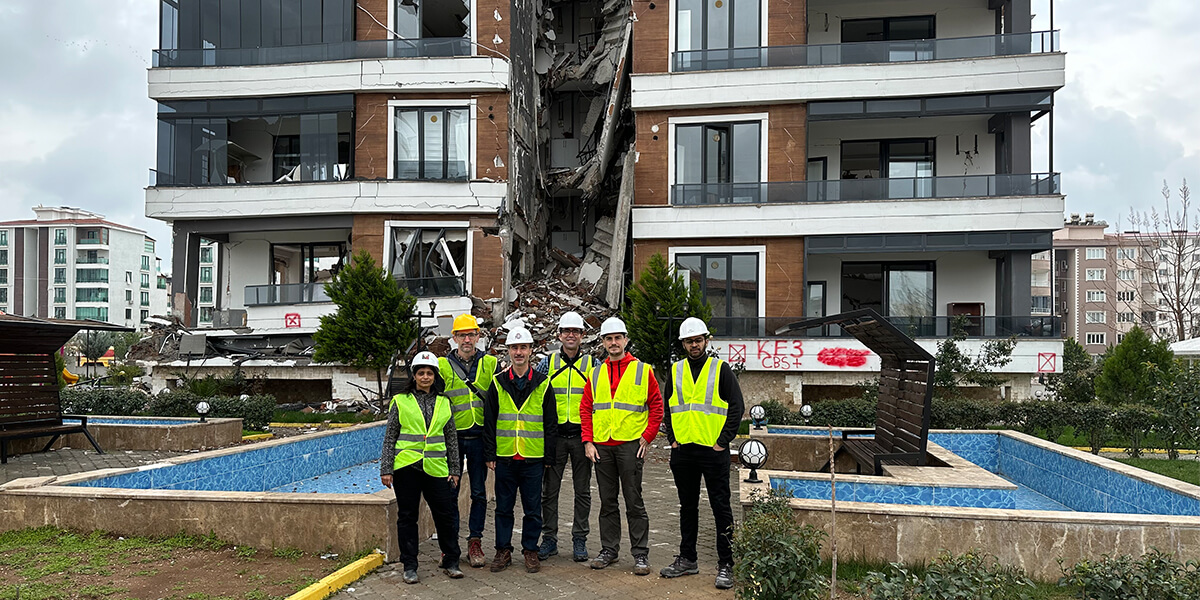
EERI Buildings Earthquake Reconnaissance Team in front of a partially collapsed building in Adiyaman. Team members from left to right: Rupa Garai (SOM), Michael Mieler (ARUP), Halil Sezen (Ohio State University), Morgan Griffith (Exponent), Bora Gencturk (USC), Parth Gudhka (IMEG).
When a 7.8 magnitude earthquake struck south-eastern Turkey in the early morning hours of Feb. 6, it was identified as the most powerful seismic incident to hit the country since 1939. When a 7.6 magnitude earthquake was triggered just a few hours later, disaster spiraled to catastrophe – many buildings that had survived the initial impact were reduced to rubble and the death toll has reportedly surpassed 50,000.
How could those buildings have been designed differently, and what lessons can be applied to boost the strength of our cities against future tectonic shifts?
That was the question posed to Bora Gencturk, an associate professor at the Sonny Astani Department of Civil & Environmental Engineering (CEE) and an expert in the resilience of reinforced concrete structures in the context of extreme events, specializing in the application of high performance materials. Gencturk was among a select group of structural engineers chosen by the Earthquake Engineering Research Institute (EERI) to travel to Turkey as part of the organization’s Learning from Earthquakes program.
The team’s on-site observations will be channeled into a comprehensive reconnaissance report informing future strategies to guide design, permitting, construction and inspection efforts. For now, Gencturk is still processing his exposure to the disaster zones – we caught up with him shortly after his return to Los Angeles.
How are you feeling since your return, and what were your first impressions?
To be honest, I’m exhausted. When you’re working in the field, you have to absorb sights of extreme destruction. Our team visited most of the affected areas while we stayed in Adana for three days and Gaziantep for four days.
According to most recent government reporting, there’s an estimate of over 60,000, buildings collapsed and another 100,000 buildings that are heavily damaged. When you’re on the streets, you mostly meet demolition workers or teams employed to remove debris – there are people living in tents and temporary housing, but otherwise the most hardly hit areas have been mostly abandoned. The majority of residents have fled the city because their homes are no longer inhabitable.
Has the experience given you a new perspective as a researcher?
It’s worth noting that these types of earthquakes are very rare events, with an average return period of anywhere from 500 to 2000 years. So, it’s very important to observe how buildings behave in such circumstances.
My research focuses on using high-performance new materials to enhance the reinforced concrete infrastructure of buildings and bridges, improving the way they respond to seismic activity. It was very important for me to witness the way these buildings fail, so we can identify solutions to prevent these failures in the future – not only in Turkey, but also in the United States and globally.
What was a typical day during the trip?
I was part of a team of 6 focusing on buildings. Other members of the EERI program included a team focusing on hospitals and another larger team focused on lifelines – infrastructure components such as ports, dams, roads and power transmission lines.
On a typical day, I’d leave very early in the morning and stay out in the field gathering information for anywhere between 8-16 hours, coming back late in the evening. We had two vans and our team would split into groups of three – accompanied by our local contacts – and travel to different locations to gain more coverage of the region.
It could take two to three hours of driving to get to our destination; we would stop based on recommendations from our local contacts, making observations from the outside and entering the less heavily damaged structures. Overall, we inspected approximately 200 buildings, in addition to general observations of the condition of areas such as historical and downtown districts. The whole team would then meet at the end of each day to debrief, swap notes and plan for the following day.
What are some of the initial takeaways from those investigations?
We’re still processing the observations and the data. From an initial overview, it appears that the main problem was the performance of residential, commercial and industrial buildings, whereas the lifelines and critical buildings such as schools and hospitals performed relatively well from a structural perspective (but not always in terms of continued operation).
We focused primarily on new buildings that were constructed after an adjustment in code that occurred after the Kocaeli earthquake in 1999. In addition to pervasive design and construction deficiencies, I noted a combination of problems that had arisen from designing according to the code minimum (not always following better engineering practice) which wasn’t sufficient when faced with a major disaster. For instance – splicing steel reinforcement at the foundation level (which was prohibited by the 2018 code change in Turkey), as opposed to higher up at the story level where the earthquake demands are lower.
The fact that critical facilities such as schools and hospitals performed fairly well structurally is a good sign – it shows that the other buildings could have withstood the earthquake if they were designed to a higher standard.
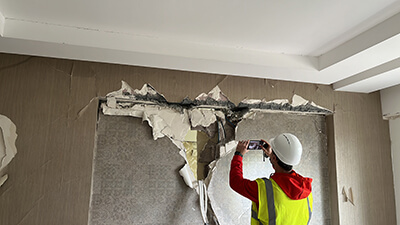
Dr. Gencturk investigating damage in a reinforced concrete beam between two shear walls.
What are the next steps for the reconnaissance report?
We are analyzing the data collected and identifying common types of failures, correlating with factors such as the number of stories in the building, the year of construction, the lateral force resisting systems and the intensity of shaking. We’re also doing case studies of certain buildings selected from the data set, referring to the earthquake ground motions in the area and seeing how these buildings performed.
This will allow us to identify what was done well and what was done poorly in terms of engineering practices – new knowledge that will allow us to accelerate understanding of how our cities can survive extreme events, preventing significant loss of life in the future.
Published on April 5th, 2023
Last updated on April 10th, 2023




